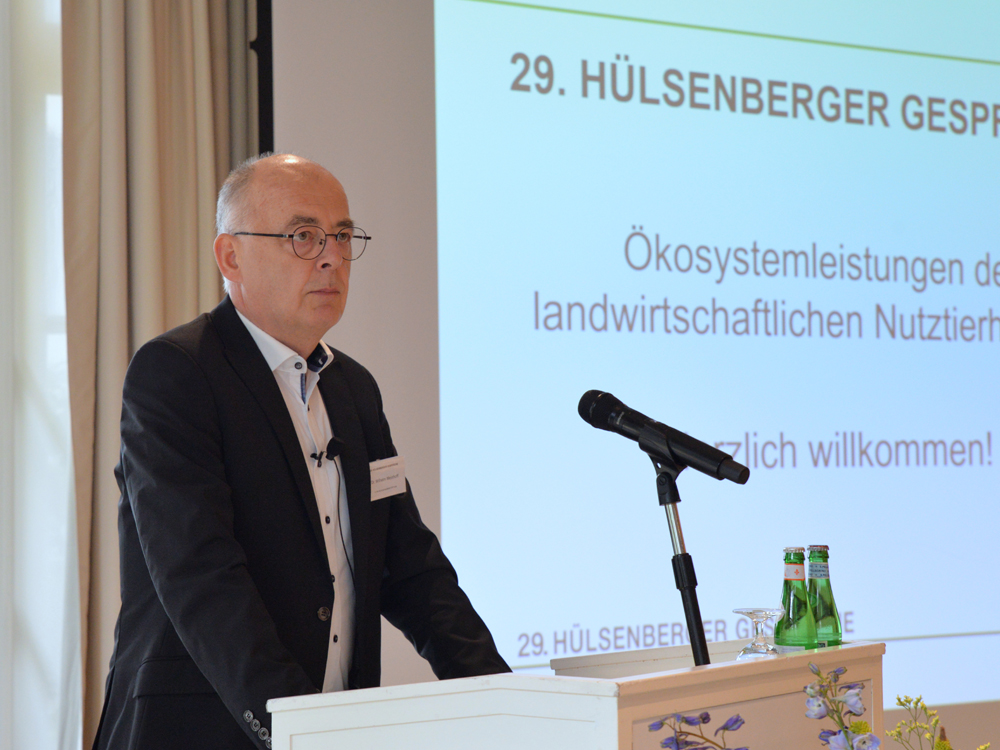
29th Hülsenberger Gespräche
18.07.2024
Ecosystem services provided by livestock farming
What supply, regulatory or cultural services do our farm animals provide? Various scientists recently addressed this question at the 29th ‘Hülsenberger Talks’ organised by the H. Wilhelm Schaumann Foundation.
‘The ecosystem services provided by our farm animals are essential for sustainable and future-proof agriculture,’ explained Dr Wilhelm Weisthoff, Chairman of the Board of Trustees of the H. Wilhelm Schaumann Foundation. At a time when the interaction between humans and the environment is increasingly becoming the focus of social debate, it is crucial to understand and assess the impact of our agricultural practices on the surrounding ecosystems. The ecosystem services of our agricultural livestock can be divided into provisioning services, i.e. the production of food and raw materials, regulating services by regulating the local climate and influencing land degradation, supporting services with soil formation and nutrient cycles, and cultural services with the provision of recreational areas.
Meat supply and meat consumption
If you want to categorise livestock farming here, you have to look at its economic conditions, among other things. Professor Martin Banse from the Thünen Institute in Braunschweig explained that these are currently characterised by the general development on international meat markets, the development of prices and therefore also the development of production. The consequences of COVID, Russian aggression against Ukraine, ASF and avian influenza or the trend towards vegetarianism and a diet with meat substitutes among some sections of the population, for example, have a concrete influence on meat production. In both Germany and the EU, there are some regions with a very high livestock density and regions with a very low livestock density of farm animals, both of which have different effects on ecosystem services. In general, meat consumption is declining in Europe. ‘Beef production will continue to fall, but pig stocks will decline even more and the winner will be poultry meat production,’ Banse predicted for Germany.
Grassland utilisation in the future with the help of intelligent technologies
Professor Johannes Isselstein from the University of Göttingen shed light on the historical development of ecosystem services through to the future prospects of pasture-based livestock farming systems and grassland use. Pasture-based animal husbandry systems always have an influence on the vegetation and thus the design of the landscape. Isselstein specifically demonstrated the change in the landscape from extensive grazing by shepherds a good 200 years ago to today's grazing methods. The provision of ecosystem services depends on the utilisation of the grassland. Heterogeneity at the landscape level is important in order to provide these continuously. As an example of current research, the speaker presented the virtual fence, which can be used to exclude individual areas from grazing and thus fence off small biotopes or preserve valuable plant species in a targeted manner. ‘Intelligent digital grassland management technologies such as virtual fencing as well as drone and satellite-supported grassland management will significantly improve grazing and thus the provision of ecosystem services at the landscape level,’ Isselstein concluded.
‘Target’ and “actual” often diverge from the consumer's point of view
Professor Jutta Roosen from the Technical University of Munich presented agricultural livestock farming from a consumer perspective based on a consumer survey in Bavaria. The image of agriculture is influenced by expectations and the perception of agriculture. For example, the respondents attested to a positive image of agriculture in the area of food security and also recognised the difficult situation of farmers. More than 80 per cent of respondents consider agriculture's contribution to ecosystem services to be important or very important, but only around 40 per cent see this claim fulfilled in terms of resource protection (soil, water, air), respect for biodiversity and climate-friendly work, Roosen stated. The ‘closer’ consumers see themselves, the more they recognise the ecosystem services provided by agriculture and livestock farming, but, according to Roosen, this requires active contact between farmers and consumers, as proximity is not created solely by a rural residence.
First plate, then trough and then tank
Professor Wilhelm Windisch from the Technical University of Munich addressed the ‘plate-trough-tank’ debate. ‘We are approaching the planetary limits of available arable land,’ he stated. While today there is still around 1,800 square metres of arable land per person worldwide, by 2050 there will only be 1,400 square metres left. The future priority will therefore be, first the plate, then the trough and then the tank. This can be implemented very well with livestock such as ruminants, which eat and utilise non-edible biomass. ‘Feeding non-edible biomass to livestock produces a double benefit: more fertiliser for plant food and additional food without competition for food. In the end, prioritisation with plate-trough-tank even makes the methane from ruminants climate-neutral,’ concluded the speaker.
© Angelika Sontheimer